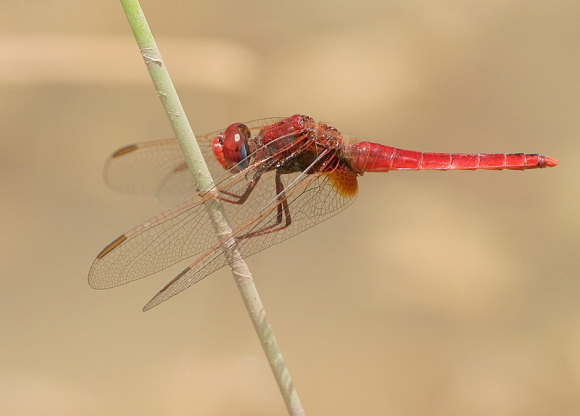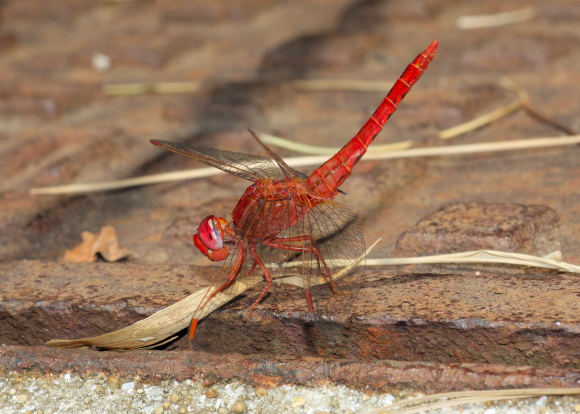Genus Crocothemis Brauer, 1868
scarlets
Synonyms:
- scientific: Beblecia Kirby, 1900 [adolescens = divisa]
Type species: Libellula erythraea Brullé, 1832
Introduction
Eight species occur from Africa, across Eurasia, to Australia, of which five are found in continental Africa and one is endemic to Madagascar. The African species are medium-sized (hindwing 23-33 mm), have limited black markings (notably absent on legs), and mature males are often largely red. They may spend long periods away from water, being reproductively inactive, and are then duller, e.g. orange, brown or greyish. C. erythraea is Africa’s most widespread odonate, found at any open habitat, and is rapidly expanding in Europe. Unlike other African Crocothemis, it does not often perch flat on vertical surfaces such as rocks, walls, termite mounds and exposed buttresses. It can be confused with the smaller C. sanguinolenta, but that species favours running water over standing, less often perches on vegetation, typically has small lateral black dashes on abdomen, and pterostigmas generally coloured similarly to abdomen, i.e. red with maturity. C. erythraea has comparatively large and straw-coloured pterostigmas, normally less bright than abdomen. With their larger pterostigmas, clear hindwing base, slender abdomen and pallid faces, C. divisa and C. saxicolor are quite different. They are most often found on rocks, frequently with Bradinopyga species, but seem to breed in grassy streams and ditches rather than rock pools. The localised C. brevistigma may be mistaken with C. divisa or C. sanguinolenta and probably also breeds in open streams, but can be separated by the spotted abdomen and the female’s vulvar scale. [Adapted from Dijkstra & Clausnitzer 2014]
Diagnosis
Male of genus is similar to Bradinopyga by (a) labium pale, legs at most with blackish tarsi; (b) hindlobe of prothorax small, roughly semicircular and widest at base (dorsal view), apex often pressed downwards (lateral view), its border with short hairs and at most a few longer hairs; (c) Fw discoidal field widens terminally, number of cell-rows just before end about double that at base, e.g. 3 and 6; (d) 8½-19½ Ax in Fw (‘½’ indicates often incomplete distal Ax); (e) sectors of arculus in Fw always fused at base, separating well distal to arculus; (f) arculus often closer to Ax2, sometimes even distal to it; (g) hook of hamule small, placed midway along large lobe which dwarfs and often conceals it; (h) anterior lamina low, much smaller than genital lobe; (i) S4 without transverse ridge, although colour pattern or scar-like seam may indicate its position, there is no ridge of similar magnitude as transverse ridge of S3 and lateral carina of S4. However, differs by (1) smaller size, Hw 23-33 mm; (2) vertex low rather than high, with rounded apices. 1-2 rows in radial planate; (3) arculus in all wings usually closer to Ax2 than Ax1. [Adapted from Dijkstra & Clausnitzer 2014; this diagnosis not yet verified by author]

Crocothemis erythraea (Brullé, 1832). Male © Paul Schrijvershof

Crocothemis sanguinolenta (Burmeister, 1839). Male © Allan Brandon
Map citation: Clausnitzer, V., K.-D.B. Dijkstra, R. Koch, J.-P. Boudot, W.R.T. Darwall, J. Kipping, B. Samraoui, M.J. Samways, J.P. Simaika & F. Suhling, 2012. Focus on African Freshwaters: hotspots of dragonfly diversity and conservation concern. Frontiers in Ecology and the Environment 10: 129-134.
References
- Lohmann, H. (1980). Zur Taxonomie einiger Crocothemis- Arten, nebst Beschreibung einer neuen Art von Madagaskar (Anisoptera: Libellulidae). Odonatologica, 10, 109-116. [PDF file]
- Dijkstra, K.-D.B, and Clausnitzer, V. (2014). The Dragonflies and Damselflies of Eastern Africa: handbook for all Odonata from Sudan to Zimbabwe. Studies in Afrotropical Zoology, 298, 1-264.
- Ris, F. (1921). The Odonata or Dragonflies of South Africa. Annals South African Museum, XVIII, 245-452. [PDF file]
- Pinhey, E.C.G. (1961). Dragonflies (Odonata) of Central Africa. Occasional Papers Rhodes-Livingstone Museum, 14, 1-97. [PDF file]
- Barnard, K.H. (1937). Notes on dragon-flies (Odonata) of the S. W. Cape with descriptions of the nymphs and of new species. Annals South African Museum, 32, 169-260. [PDF file]
- Kirby, W.F. (1900). Report on the Neuroptera Odonata collected by Mr E. E. Austen at Sierra Leone during August and September 1899. Annals Magazine Natural History, 6, 67-79. [PDF file]
Citation: Dijkstra, K.-D.B (editor). African Dragonflies and Damselflies Online. http://addo.adu.org.za/ [2024-07-27].

